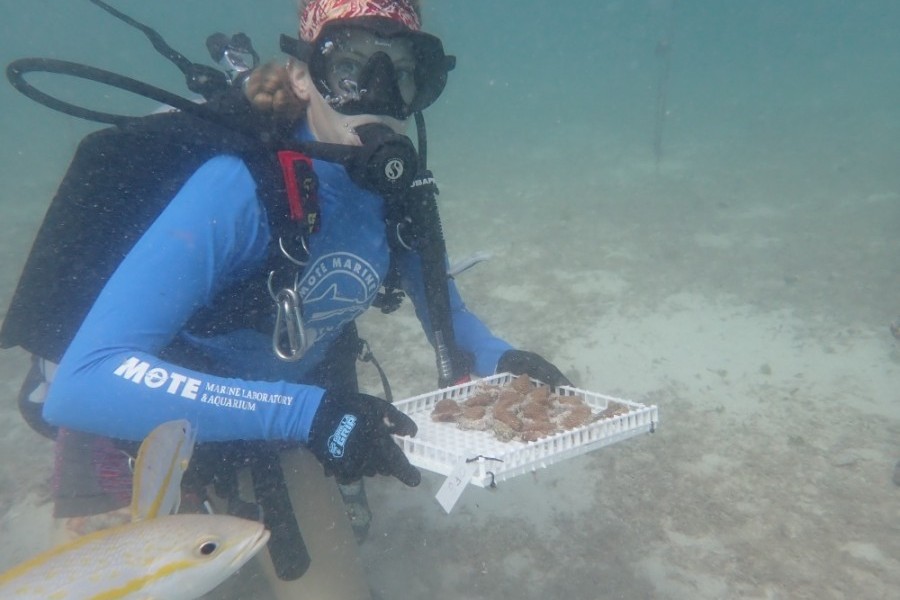The future of coral reef restoration depends on science and collaboration
Florida’s Coral Reef experienced record-breaking heat waves during the summer of 2023 caused by unusually high seawater temperatures that started early in the season, resulting in mass coral bleaching in certain areas. Florida’s reef managers, scientists, conservation organizations and reef users, sounded the alarm and worked collectively to protect restoration investments, to preserve genetic diversity, and to enact monitoring to better understand the extent and potential impacts of the bleaching.
The Florida Reef Resilience Program (FRRP), a consortium of stakeholders managed by The Nature Conservancy (TNC) on behalf of the reef management agencies, focuses on developing strategies for mitigating climate change and other stressors that decrease the Reef’s resilience. The FRRP focused on implementing Florida’s Bleaching Response Plan by communicating about the risk of bleaching and making decisions about how best to track changes on the Reef through the Disturbance Response Monitoring (DRM) program. The DRM program, led by Florida Fish and Wildlife Conservation Commission and contributed to by agency and academic partners, was created in 2005 to check the condition of shallow water reefs from Dry Tortugas National Park to Martin County during the annual period of peak heat stress. If warranted, follow-up surveys conducted three to four months after a bleaching event help reef managers understand the impacts of severe bleaching by providing data on whether corals recovered or perished as a result of the event.
Mote Marine Laboratory, an FRRP partner with significant investments in coral reef restoration, immediately began an unprecedented evacuation of thousands of stressed and dying coral from its four offshore coral nurseries in July.
With the help of over 70 staff members, six Mote research vessels, and immense support from the community and other partners, Mote carefully transported thousands of stressed and dying corals from its offshore nurseries to its three land-based coral nurseries in the Keys, as well as to its Sarasota-based Mote Aquaculture Research Park
Expert staff continue to work diligently to aid in the recovery of these stressed and dying corals with a goal of saving as many of them as possible despite exposure to the extreme water temperatures of over 90°F.
“Mote has invested in science-based coral reef restoration and research for nearly 30 years and, as such, we were equipped with the land-based infrastructure to provide tens of thousands of corals a safe place to grow until conditions improve on the reef,” said Dr. Michael Crosby, Mote President and CEO. “The goal is to place all remaining, healthy coral back into our offshore nurseries and resume our regular science-based restoration efforts as soon as the conditions allow.”
Mote has been studying coral ecosystems for decades, and employs a holistic approach to science-based restoration efforts including sexual reproduction, asexual reproduction, coral gene banking, and utilizing both onshore and offshore coral nurseries.
As an international leader in the development of innovative and effective coral reef restoration technologies, Mote has recent breakthroughs in identifying natural coral genotypes that are resilient to increased ocean temperature, acidification, and disease.
“Coral reefs are experiencing unprecedented die-offs worldwide, and it’s critical to restore them with resilient and genetically diverse corals that have the best chances to survive and reproduce,” said Dr. Jason Spadaro, Mote’s Coral Reef Restoration Research Program Manager. “Now is not the time to give up, now is the time to ramp up resilience-based restoration efforts and embrace the challenge.”
In addition to conducting restoration, Mote participates in DRM surveys each year the DRM program not only captures a snapshot of the extent of bleaching each year, but the data can also be used to target restoration in resilient areas, attempt to replicate ecological conditions through restoration, and incorporate any potentially resilient genetics into our restoration portfolios. This long-term data set has proven invaluable in the development of a statewide restoration strategy under the lead of TNC.
Click the links for more information about FRRP and Disturbance Response Monitoring. To report observations of bleaching in the Florida Keys, visit Mote’s BleachWatch site, and in Southeast Florida visit the SEAFAN BleachWatch site.
